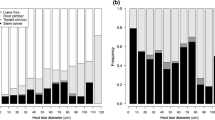Abstract
The spatial distribution of stolons ofWisteria floribunda DC. was investigated, and the ecological significance of clonal growth of this temperate liana is discussed. The study plot (0.15 ha) was located in a secondary deciduous broad-leaved forest dominated byQuercus serrata in central Japan. The tree canopy was almost closed with a mean openness of 4.2%.W. floribunda was dominant among lianas accounting for 86% of their total basal area.W. floribunda stolons of three individuals branched numerous times and intersected among individuals, and showed a large horizontal “web-like” extension on the ground. The total length of stolons was 66.0, 260.2, and 310.6 m, respectively, for each individual. A mean of 25 ramets were established on stolons per individual, and one-third of the ramets obtained a host tree. These results suggested that the expansion of stolons was effective in obtaining host trees forW. floribunda individuals. On the other hand, clonal growth ofW. floribunda did not always contribute to vertical growth of ramets in the study forest, since few ramets reached the forest canopy. Lack of sub-canopy trees in this forest appeared to constrain the vertical growth ofW. floribunda ramets, since sub-canopy trees are thought to bridge lianas from smaller trees to canopy trees.
Similar content being viewed by others
Literature cited
Anderson, M.C. (1964) Light relations of terrestrial plant communities and their measurement. Biol. Rev. 39: 425–486.
Angevine, M.W. (1983) Variations in the demography of natural populations of the wild strawberriesFragaria vesca andF. virginiana. J. Ecol. 71: 959–974.
Bell, P.R. (1958) Twining of hop (Humulus lupulus L.). Nature (London) 181: 1009–1010.
Cook, R.E. (1985) Growth and development in clonal plant populations.In Population biology and evolution of clonal organisms. Jackson, J.B., Buss, L.W., and Cook, R.E. (eds.), 530pp, Yale University Press, New Haven, 259–296.
Den Dubbelden, K.C. and Oosterbeek, B. (1995) The availability of external support affects allocation patterns and morphology of herbaceous climbing plants. Funct. Ecol. 9: 628–634.
Dushyantha, K., Wijesinghe, D.K., and Hutchings, M.J. (1996) Consequences of patchy distribution of light for the growth of the clonal herbGlechoma hederacea. OIKOS 77: 137–145.
Gartner, B.L. (1991) Relative growth rates of vines and shrubs of western poison oak,Toxicodendron diversilobum. Am. J. Bot. 78: 1345–1353.
Harper, J.L. (1985) Module, branches, and the capture of resources.In Population biology and evolution of clonal organisms. Jackson, J.B.C., Buss, L.W., and Cook, R.E. (eds.), 530pp, Yale University Press, 1–33.
Ino, Y. and Ohshima, Y. (1973) On the growth and life history ofPueraria lobata. Sci. Res. Fac. Edu. Waseda Univ. 22: 78–87. (in Japanese)
Kitamura, S. and Murata, G. (1971) Colored illustrated flora of Japan (I). 453pp, Hoikusha, Tokyo. (in Japanese)
Marshall, C. (1990) Source-sink relations of interconnected ramets.In Clonal growth in plants. Groenendael, J. and de Kroon, H. (eds.), 196pp, Academic Publishing, Hague, 23–41.
Masaki, T., Suzuki, W., Niiyama, K., Iida, S., Tanaka, H., and Nakashizuka, T. (1992) Community structure of a species-rich temperate forest, Ogawa Forest Reserve, central Japan. Vegetatio 98: 97–111.
Nakagoshi, N. (1984) Ecological studies on the buried viable seed population in soil of the forest communities in Miyajima Island, southwestern Japan II. Hikobia 9: 109–122.
Nakagoshi, N. (1985) Buried viable seeds in temperate forests.In The population structure of vegetation. White, J. (ed.), 666pp, Dr. W. Junk Publishers, Dordrecht, 551–570.
Peñalosa, J. (1983) Shoot dynamics and adaptive morphology ofIpomea phillomega (Vell.) House (Convolvulaceae), a tropical rainforest liana. Ann. Bot. 52: 737–754.
Putz, F.E. (1984) The natural history of lianas on Barro Colorado Island, Panama. Ecology 65: 1713–1724.
Putz, F.E. and Chai, P. (1987) Ecological studies of lianas in Lambir National Park, Sarawaku, Malaysia. J. Ecol. 75: 523–531.
Sakai, A. and Suzuki, W. (1999) Effect of support on the growth of a woody vine,Wisteria floribunda DC. (Leguminosae). J. For. Res. 4: 183–186.
Salzman, A.G. and Parker, M.A. (1985) Neighbors ameliorate local salinity stress for a rhizomatous plant in a heterogeneous environment. Oecologia 65: 273–277.
Silvertown, J.W. and Lovett-Doust, J. (1993) Introduction to plant population biology. 210pp, Blackwell, London.
Slade, A.J. and Hutchings, M.J. (1987a) The effect of nutrient availability on foraging in the clonal herbGlechoma hederacea. J. Ecol. 75: 95–112.
Slade, A.J. and Hutchings, M.J. (1987b) Clonal integration and plasticity in foraging behavior inGlechoma hederacea. J. Ecol. 75: 1023–1036.
Suzuki, W. (1987) Comparative ecology ofRubus species (Rosaseae) I. Ecological distribution and life history characteristics of three species,R. palmatus var.coptophyllus, R. microphyllus andR. crataegifolius. Pl. Sp. Biol. 2: 85–100.
Tsugawa, H., Shimizu, T., Sasek, T.W., and Nishikawa, K. (1992) The climbing strategy of kudzu-vine (Pueraria lobata) I. Comparisons of branching behavior, and dry matter and leaf area production between staked and no stake kudzu plants. Sci. Rep. Fac. Agric. Kobe Univ. 20: 1–6.
Author information
Authors and Affiliations
Corresponding author
About this article
Cite this article
Sakai, A., Nomiya, H. & Suzuki, W. Horizontal distribution of stolons of a temperate lianaWisteria floribunda DC. and its ecological significance. J For Res 7, 125–130 (2002). https://doi.org/10.1007/BF02762600
Received:
Accepted:
Issue Date:
DOI: https://doi.org/10.1007/BF02762600




